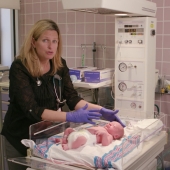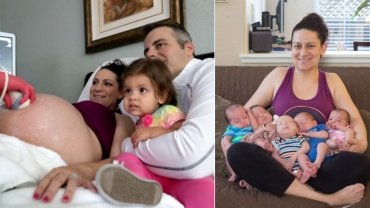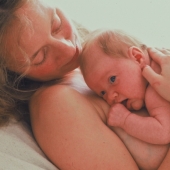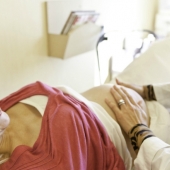VBAC, you'll hear people use the acronym VBAC, means vaginal birth after cesarean. Now in this country and especially in London, we really really recommend that if you've had a cesarean section the first time that you really try and have a vaginal birth the next time. So VBAC stands for vaginal birth after cesarean.
And the reasons for that are many and firstly that 75% of women at this hospital who have had a cesarean section the first time go on to have a completely normal vaginal birth the second time. And so that's really good because having a cesarean as you know is a major abdominal surgery and there are increased risks with that, and the risks really fall into three categories.
Firstly for you. So the risks for you as a mummy is that you're more likely to have a hemorrhage to bleed a lot. You're more likely to get an infection. You're more likely to have a blood clot in either your lungs or your legs. And also there's risks of surgical damage to your bladder and your bowel as it's as I said major abdominal surgery through your abdomen.
For your baby. Babies born by cesarean section had more breathing difficulties and some of those require the baby to go to the special care baby unit, and you also have a longer stay in hospital. I didn't mention that and but I think there are also effects on if you want to go on and have more children.
There's a slight increased risk of infertility following cesarean section, there's an increased risk of placenta previa. This is where the placenta lies before the baby so that you know if you go into labor you can have bleeding throughout your pregnancy.
There's also an increased risk of something we call placenta accreta, and that's really where the placenta embeds into that scar in your uterus and this can be very dangerous when they come to do the cesarean section, and often necessitates the need for a hysterectomy. You know it's quite a life-threatening thing. The risk is very small but it's a very serious risk.
And one of the other things they found out is one of the increased risks the more caesareans you have is the more likely you are to have a stillbirth in your following pregnancies. So for those reasons although the risk is small obviously if you have one of those things that risk is not small to you.
So as North Central London so that's the Whittington UCH Barnet and Chase ourselves and the Royal Free, we all got together and we've written all these risks down for you on an information sheet, so that you know and you can make an informed choice about the way you'd like to proceed when you've had a severe infection the first time. Because as long as you know and understand the risks it is your body, your baby, your birth and we're here to support you.
What Does Latent Phase of Labour Mean?
What Does Vaginal Birth After Cesarean Section (VBAC) Mean?
What is a Water Birth an What Are the Pros and Cons?
What Are My Options for Pain Relief During Labour?
- 26 views













